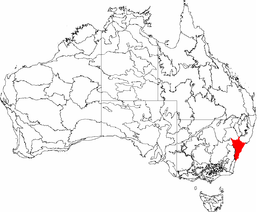Tharawal
- This article is for the Australian Indigenous group. For their language see Aboriginal language.
| Tharawal people | |
|---|---|
|
aka: Dharawal, Darawal, Carawal, Turawal, Thurawal, Thurrawal, Thurrawall, Turu-wal, Turuwul, Turrubul, Turuwull Tharawal (AIATSIS), nd (SIL)[1] | |
 Sydney Basin bioregion | |
| Hierarchy | |
| Language family: | Pama–Nyungan |
| Language branch: | Yuin–Kuric |
| Language group: | Yora |
| Group dialects: | Tharawal[2] |
| Area | |
| Bioregion: | Sydney Basin |
| Location: | Sydney and Illawarra, New South Wales |
| Coordinates: | 34°S 151°E / 34°S 151°ECoordinates: 34°S 151°E / 34°S 151°E |
| Rivers | Georges and Shoalhaven |
| Notable individuals | |

The Dharawal people are an indigenous people of Australia, are those Australian Aboriginals that are united by a common language, strong ties of kinship and survived as skilled hunter–fisher–gatherers in family groups or clans scattered along the coastal area of what is now known as the Sydney basin, in New South Wales.
Name
Tharawal means cabbage palm.[3]
Language
The Dharawal (or Tharawal) language is considered the main dialect of the Dharawal people.[2]
Country
According to Norman Tindale, the Tharawal's traditional lands encompass some 450 square miles (1,200 km2) from the south of Sydney Harbour, through Georges River, Botany Bay, Port Hacking and south beyond the Shoalhaven River to the Beecroft Peninsula. Their inland extent reaches Campbelltown and Camden.[4]
Clans
The Gweagal were also known as the "Fire Clan". They were the people to first make contact with Captain Cook.
Lifestyle
The historical artwork (rock engravings) of the Dharawal people is visible on the sandstone surfaces throughout their language area and charcoal and ochre paintings, drawings and hand stencils can be found on hundreds of rock surfaces and in the many dozens of rock shelters and overhangs in that area of land. There is a public viewing site of one group of engravings at Jibbon Point, showing a whale and a wallaby, celebrating successful hunts and whale strandings.[5] Those engravings are marred by recent European inclusions. The original Jibbon point engravings (pecked and abraided petroglyphs) show a pod of killer whales hunting a seal. The leading whale is shown as a scarified and initiated animal indicating his status as a totemic spirit of high esteem.
It has been claimed that there were no remaining descendants of the Dharawal people, however after the Mabo v Queensland verdict and the Native Title Act 1993 there have been claims lodged by descendants of the Wodiwodi Clan who claim to have survived the early decimations and gradually moved back into the areas formally occupied by other clans. These Wodi Wodi clansmen are claiming lineage to the Dharawal tribe.
The Dharawal people lived mainly by the produce of local plants, fruits and vegetables and by fishing and gathering shell fish products. The men also hunted land mammals and speared fish. The women collected the vegetable foods and were well known for their fishing and canoeing prowess. There are a large number of shell middens still visible in the areas around the southern Sydney area and a glimpse of the Dharawal lifestyle can be drawn from an understanding of the kitchen rubbish left on the midden sites.
Alternative names
- Darawad
- Carawal. (Pacific islands phonetic system, c had the value of th)
- Turawal
- Thurawal
- Thurrawal
- Thurrawall
- Turuwal
- Turuwul
- Turrubul
- Turuwull
- Ta-ga-ry. (tagara = north)
- Five Islands tribe[4]
Notes
- ↑ This map is indicative only
Citations
- ↑ Dousset 2005.
- 1 2 AIATSIS 2012.
- ↑ Organ & Speechley 1997, p. 7.
- 1 2 Tindale 1974, p. 198.
- ↑ Watt 2014, p. 104.
Sources
- Dousset, Laurent (2005). "Tharawal". AusAnthrop (Australian Aboriginal tribal database). Archived from the original on 16 October 2014. Retrieved 4 January 2013.
- Goodall, Heather; Cadzow, Allison (2014). "Gogi". Dictionary of Sydney. Dictionary of Sydney Trust. Retrieved 9 October 2015.
- "Language information: Dharawal". AIATSIS. 23 August 2012. Retrieved 4 January 2013.
- Organ, Michael K.; Speechley, Carol (1997). "Illawarra Aborigines - an Introductory History". In Hagan, J. S.; Wells, A. A History of Wollongong. University of Wollongong Press. pp. 7–22.
- Ridley, William (1875). Kámilarói, and other Australian languages (PDF). Sydney: T. Richards, government printer.
- Tindale, Norman Barnett (1974). "Tharawal(NSW)". Aboriginal Tribes of Australia: Their Terrain, Environmental Controls, Distribution, Limits, and Proper Names. Australian National University Press. ISBN 978-0-708-10741-6.
- Watt, Bruce (2014). The Shire: A journey through time. China: Everbest. p. 104. ISBN 9780646920191.
External links
- Tharawal Aboriginal Corporation webpage
- Local Aboriginal Land Council Facebook webpage
- Norman B. Tindale's "Catalogue of Australian Aboriginal Tribes", South Australian Museum.
- Bibliography of Tharawal people and language resources, at the Australian Institute of Aboriginal and Torres Strait Islander Studies